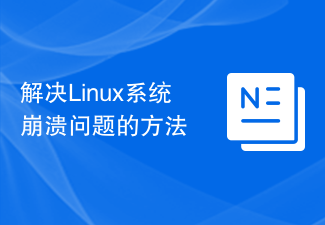
How to deal with data serialization issues in C development
In C development, data serialization is a very important issue. Data serialization refers to the process of converting data from memory into binary data for transmission and storage between different platforms and different systems. Data serialization is one of the key technologies to achieve network communication, data storage and data transmission.
C is a powerful programming language with excellent performance and flexibility, so it is widely used in many fields, including network communications, big data processing, graphics processing, and embedded systems. In these applications, data serialization is an essential link. Therefore, how to efficiently handle data serialization issues in C development has become a challenge that every C developer must face.
1. Choose a suitable serialization library
Choosing a suitable serialization library is the first step in dealing with data serialization issues in C development. When choosing a serialization library, you need to consider the following points:
- Function and performance of the library: Different serialization libraries provide different functions and performance. Choosing an appropriate serialization library based on actual needs can improve development efficiency and performance.
- Cross-platformness of the library: Cross-platformness is an important consideration. Choosing a serialization library with good cross-platform support can ensure that it works well on different operating systems and hardware platforms.
- Ease of use of the library: Choosing an easy-to-use serialization library can reduce developers’ learning costs and development cycles.
- Documentation and community support for the library: Good documentation and active community support are very important for developers. When you encounter problems, you can solve them by consulting the documentation and asking questions to the community.
Common C serialization libraries include Google Protobuf, Boost.Serialization, Msgpack, etc. Each library has its own characteristics and applicable scenarios. Choose according to actual needs.
2. Define the data structure and protocol
Before data serialization, the data structure and communication protocol need to be clarified. The data structure defines the format and organization of the data that needs to be transmitted, and the communication protocol defines the data transmission rules and processes.
When defining a data structure, factors such as data type, size, and alignment need to be considered. Data types can be basic types (such as integers, floating point numbers, and strings) or custom types (such as structures and classes). Data size and alignment may vary across platforms and compilers and need to be handled accordingly.
The communication protocol can be a custom protocol or a standard protocol (such as HTTP, TCP/IP). A custom protocol needs to clarify information such as the order of data transmission, the format of the message header and message body, and other information.
3. Implement data serialization and deserialization functions
In C, implementing data serialization and deserialization functions is a key step in dealing with data serialization issues. The data serialization function converts data from memory to binary data, and the deserialization function converts binary data to data in memory.
When implementing data serialization and deserialization functions, you need to pay attention to the following points:
- Encoding and decoding of data: Data serialization and deserialization functions need to implement data The encoding and decoding process ensures the correct transmission and recovery of data.
- Endianness processing: Different systems and platforms may use different byteorders (such as big-endian and little-endian), and corresponding processing needs to be carried out according to the actual situation.
- Data integrity check: When deserializing data, data integrity check is required to avoid program crashes or data errors due to data damage or transmission errors.
4. Test and optimize
After implementing the data serialization function, testing and optimization need to be carried out. Testing includes unit testing and integration testing to ensure the correctness and performance of data serialization and deserialization functions.
Optimization mainly includes reducing the time and space complexity of data serialization and deserialization. Optimization can be achieved by reducing data copying, compressing data, and using more efficient data structures.
Summary:
Data serialization is an indispensable link in C development, involving many aspects such as network communication, data storage and data transmission. To deal with data serialization issues, you need to choose an appropriate serialization library, define data structures and communication protocols, implement data serialization and deserialization functions, and conduct testing and optimization. Only by mastering effective data serialization methods can we better develop C and improve development efficiency and performance.
The above is the detailed content of How to deal with data serialization issues in C++ development. For more information, please follow other related articles on the PHP Chinese website!
 如何处理C++开发中的数组越界问题Aug 21, 2023 pm 10:04 PM
如何处理C++开发中的数组越界问题Aug 21, 2023 pm 10:04 PM如何处理C++开发中的数组越界问题在C++开发中,数组越界是一个常见的错误,它能导致程序崩溃、数据损坏甚至安全漏洞。因此,正确处理数组越界问题是保证程序质量的重要一环。本文将介绍一些常见的处理方法和建议,帮助开发者避免数组越界问题。首先,了解数组越界问题的原因是关键。数组越界指的是访问数组时超出了其定义范围的索引。这通常发生在以下场景中:访问数组时使用了负数
 如何解决C++开发中的文件权限问题Aug 21, 2023 pm 09:03 PM
如何解决C++开发中的文件权限问题Aug 21, 2023 pm 09:03 PM如何解决C++开发中的文件权限问题在C++开发过程中,文件权限问题是一个常见的挑战。在许多情况下,我们需要以不同的权限访问和操作文件,例如读取、写入、执行和删除文件。本文将介绍一些解决C++开发中文件权限问题的方法。一、了解文件权限在解决文件权限问题之前,我们首先需要了解文件权限的基本概念。文件权限指的是文件的拥有者、拥有组和其他用户对文件的访问权限。在Li
 如何处理C++开发中的命名冲突问题Aug 22, 2023 pm 01:46 PM
如何处理C++开发中的命名冲突问题Aug 22, 2023 pm 01:46 PM如何处理C++开发中的命名冲突问题在C++开发过程中,命名冲突是一个常见的问题。当多个变量、函数或类具有相同的名称时,编译器无法判断具体引用的是哪个,从而导致编译错误。为了解决这个问题,C++提供了几种方法来处理命名冲突。使用命名空间命名空间是C++中处理命名冲突的一种有效方法。通过将相关的变量、函数或类放置在同一个命名空间中,可以避免名称冲突。例如,可以创
 如何处理Win11系统无法安装中文包的问题Mar 09, 2024 am 08:39 AM
如何处理Win11系统无法安装中文包的问题Mar 09, 2024 am 08:39 AM标题:如何处理Win11系统无法安装中文包的问题随着Windows11操作系统的推出,许多用户纷纷升级到了这个全新的系统版本。然而,在使用过程中,一些用户可能会遇到Win11系统无法安装中文包的问题,导致系统界面无法显示正确的中文字符,给用户的日常使用带来了困扰。那么,如何解决Win11系统无法安装中文包的问题呢?本文将为大家详细介绍解决方法。首先,出现无
 解决Linux系统崩溃问题的方法Jun 30, 2023 pm 01:04 PM
解决Linux系统崩溃问题的方法Jun 30, 2023 pm 01:04 PM如何处理Linux系统中出现的系统崩溃问题Linux是一种开源操作系统,被广泛应用于服务器、主机和嵌入式系统。然而,就像其他任何操作系统一样,Linux也可能遇到系统崩溃的问题。系统崩溃可能导致数据丢失、应用程序崩溃以及系统不可用等严重后果。在本文中,我们将探讨如何处理Linux系统中出现的系统崩溃问题,以保证系统的稳定性和可靠性。分析崩溃日志首先,当Lin
 如何处理Linux系统中频繁出现的内存耗尽问题Jul 01, 2023 am 10:45 AM
如何处理Linux系统中频繁出现的内存耗尽问题Jul 01, 2023 am 10:45 AM如何处理Linux系统中频繁出现的内存耗尽问题在Linux系统中,内存耗尽是一个经常出现的问题,尤其是在服务器上和资源使用较高的应用程序中。当系统内存耗尽时,系统性能将受到严重影响,很可能会导致系统崩溃甚至无法启动。本文将介绍一些处理Linux系统中频繁出现的内存耗尽问题的方法。一、了解内存的使用情况首先,我们需要了解系统的内存使用情况。可以使用命令“fre
 如何处理C++开发中的图像清晰化问题Aug 21, 2023 pm 08:57 PM
如何处理C++开发中的图像清晰化问题Aug 21, 2023 pm 08:57 PM如何处理C++开发中的图像清晰化问题摘要:清晰化图像是计算机视觉和图像处理领域一个重要的任务。本文将讨论如何使用C++来处理图像清晰化问题。首先介绍图像清晰化的基本概念,然后探讨几种常用的清晰化算法,并给出使用C++实现这些算法的示例代码。最后,给出一些优化和改进的建议,以提高图像清晰化的效果。引言图像清晰化是图像处理领域的一项重要任务,它旨在提高图像的视
 Vue开发中的拖拽上传文件处理技巧Jun 30, 2023 pm 10:13 PM
Vue开发中的拖拽上传文件处理技巧Jun 30, 2023 pm 10:13 PM如何处理Vue开发中遇到的拖拽上传文件问题随着Web应用程序的发展,越来越多的需求需要用户上传文件。而在Vue开发中,拖拽上传文件成为了一种流行的方式。但是,在实际开发过程中,我们可能会遇到一些问题,比如如何实现拖拽上传、如何处理文件格式和大小限制等。本文将介绍如何处理Vue开发中遇到的拖拽上传文件问题。一、实现拖拽上传要实现拖拽上传文件的功能,我们需要以下


Hot AI Tools

Undresser.AI Undress
AI-powered app for creating realistic nude photos

AI Clothes Remover
Online AI tool for removing clothes from photos.

Undress AI Tool
Undress images for free

Clothoff.io
AI clothes remover

AI Hentai Generator
Generate AI Hentai for free.

Hot Article

Hot Tools

SAP NetWeaver Server Adapter for Eclipse
Integrate Eclipse with SAP NetWeaver application server.

EditPlus Chinese cracked version
Small size, syntax highlighting, does not support code prompt function

Dreamweaver Mac version
Visual web development tools

Notepad++7.3.1
Easy-to-use and free code editor

VSCode Windows 64-bit Download
A free and powerful IDE editor launched by Microsoft






